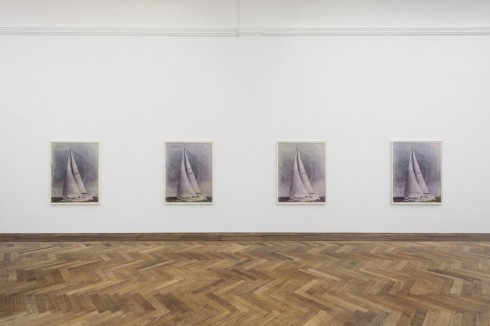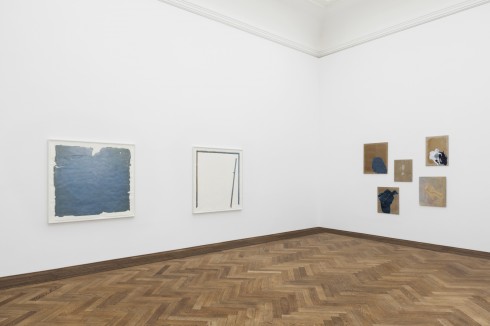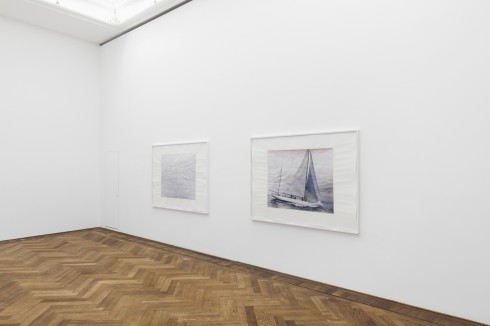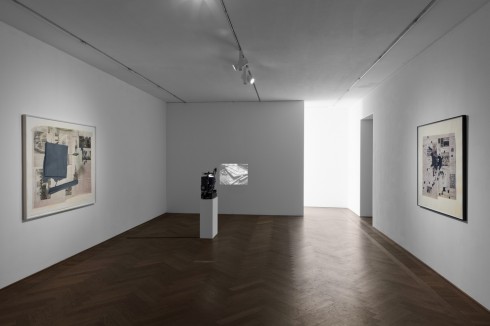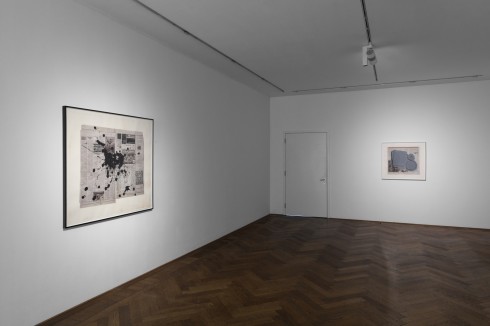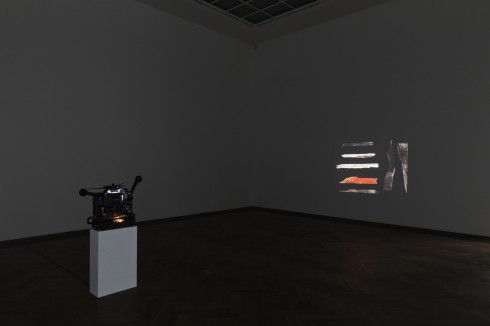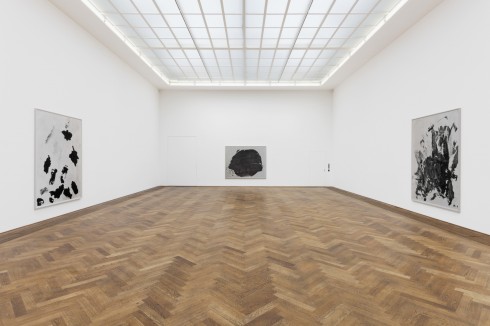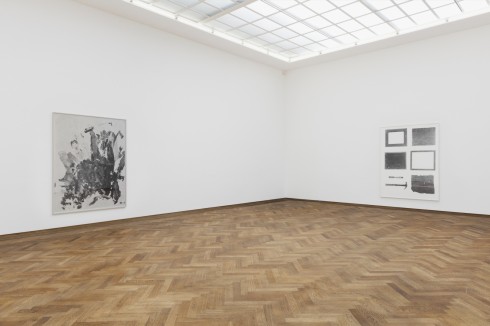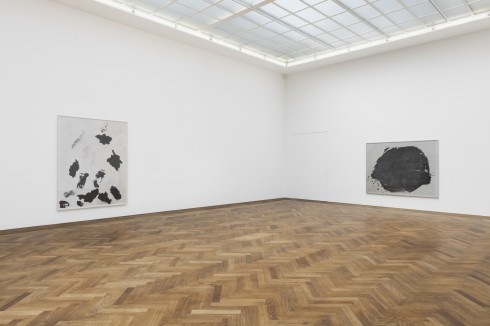Kunsthalle Basel is proud to present the first comprehensive exhibition in Europe of recent works by Paul Sietsema.
Born in 1968, the Los Angeles and Berlin based artist has lately been receiving considerable attention for his films and other works. Each specific work by Paul Sietsema can be described as a formalization of the work process — the end phase or perhaps just the suspension of this process — following several years of researching, constructing and layering of the varied, often personally connoted cultural material. Thus, the durational character of films is equaled by the duration of the process of their making — a particular work ethic that informs the work’s proper subject, while the motif and medium may vary. Sietsema’s drawings and paintings, often realized with the use of idiosyncratic, labor-intensive techniques devised by the artist, usually involve working through existing artifacts, which serve as a starting point for series of material transformations. Thus, a conventional found photograph of a sail boat was used for the series of four Calendar boats (2012). The work emerged in a complex process involving mechanical reproduction, coating the surface with latex and stripping it off after it was treated with ink. In works such as Painting for assembly, State museum painting or Chinese philosophy painting (all 2012), the artist restretched the canvases of found paintings of minor historical value back to front on the original stretchers to show their empty, unprimed surface and use it for making new enamel paintings.
The films, shot on 16 mm, are composed of still images of specific objects, collected and manipulated by the artist, staged in sequences or encounters among things that can range from found objects to drawings, painting frames and photographic prints. Sietsema’s interest in the very idea of work corresponds to his inquiry in the material quality of pre-digital era images, which cannot be separated from their carriers and in time show signs of wear and change — such as celluloid tape and photographic paper. Prior to the finished artwork, the laborious treatment of the objects brings them in relation with their function and history. The circumstances of the objects’ own making are revealed precisely through their careful unmaking in the studio, a process to which younger artists are often invited to contribute. A plural authorship is thus created, while the errors made by beginners are incorporated to the final result.
Paul Sietsema uses his studio not as a work place where ideas assume physical shape, but as an allegory of work and a “printer” of ideas and things, a site where generative and transformative grammar of production is revealed. As a first step, the physical constituents of a painting or drawing, such as stretcher, back paper, frame and glass, may be laid bare, such as in the new film Encre Chine (2012), which features a selection of picture frames and other cultural debris from Sietsema’s rich collection that were then placed on a work table and covered with layers of viscous black ink. This process of transformation — from specific objects with specific history and, perhaps, iconography, to a pool of black ink, erasing the objects’ individuality and lending them a look of a lava field — can be compared to the act of naming, or rather renaming, once familiar things. In their place, another kind of “thingness” is forged, dissolving the historicity of individual object in the opaque deep of black monochrome relief, similar to a landscape of mud after the flood. The other film in the show, Telegraph (2012) introduces a phrase “LETTER TO A YOUNG PAINTER”, whereupon only one letter is visible at a time, to be then replaced by the subsequent one in slow-paced succession. The letters are “built” of pieces of wood found on sites of houses that were destroyed by hurricane Katrina when it hit New Orleans. There is almost no narrative development in this and other films by Sietsema, but rather a diachronic construction, similar to that of a sentence, created by adding isolated images over a period of time.
Sietsema’s working process is essentially always about reworking — or working into — the image and its carrier. Thus, the banality or any historical and emotional value that a given “original” image or object may have had, gives way to the art work that, while retaining some characteristic of the “original”, is new, and while degrading some of the inherent “value” of the source material, simultaneously elevates it. Sietsema treats images as facts which need to be explored and whose meaning can be significantly expanded. The exhibition includes a group of works on meticulously hand-copied newspaper spreads, with their usual mix of current events from politics, culture and human interest, partly obliterated by representations of objects, mostly painter’s tools, submerged in and surrounded by splashes of paint. These works, such as Untitled figure ground study (Degas/Obama) or Untitled figure ground study (facing German suffering) (both 2011) establish a disquieting interplay between the flat surface of newspaper, carrying the now historical and formerly “hot” news.
In the last gallery, four large paintings with ink on paper are on view, all made in 2012. Three of them — Light fall 1 (plume), Light fall 2 (cutting daisies) and Light fall 3 (leaflet drop) — are based on illustrations culled from a book published by the MoMA in New York in the 1950s, including drawings made by museum visitors in reaction to abstract expressionist paintings on display. The titles allude to war events — a “daisy cutter” is an American bomb used in Vietnam and Afghanistan to flatten a clearing in a forest to prepare it for helicopter landing, plume and leaflet drops connote destruction and propaganda. The fourth work, likewise in ink on paper Untitled vertical array, features the essentials of painting, the frame, stretcher, back paper, as well as a hammer and chisel, two handy tools from the artist’s studio, used to disassemble paintings, but also, perhaps, standing in for a hammer and sickle.
Paul Sietsema (*1968 Los Angeles, US) lives and works in Los Angeles and Berlin, DE. Sietsema studied at the University of California, Berkeley and the University of California, Los Angeles, where he graduated with the Master of Fine Arts in 1999. In 2002 he was awarded the Foundation for Contemporary Arts Award for Visual Arts. Furthermore he received the John Simon Guggenheim Memorial Foundation Fellowship in 2005 and the DAAD (German Academic Exchange Service) Fellowship in Berlin in 2008.
Solo exhibitions (selction): Paul Sietsema, Wexner Center for the Arts, Columbus, Ohio (2012); Paul Sietsema: Anticultural Positions, Schinkel Pavillon, Berlin (2010); Figure 3, Museum of Modern Art, New York (2009); Paul Sietsema, Museo Nacional Centro de Arte Reina Sofia, Madrid (2009); Paul Sietsema, San Francisco Museum of Modern Art, San Francisco (2008); Paul Sietsema: Three Films, de Appel Foundation, Amsterdam (2008). Group exhibitions (selection): Drawn from Photography, The Drawing Center, New York (2011); Exhibition of Distances, Tulips and Roses, Brussels (2011); All of this and nothing, Hammer Museum, Los Angeles (2011); The Artist’s Museum, Museum of Contemporary Art Los Angeles, Los Angeles (2010); NOVEL, dependence, Brussels (2010); Following A Line, Contemporary Art Gallery, Vancouver, (2010); Hauntology, Berkeley Art Museum and Pacific Film Archive, University of Berkeley, Berkeley (2010); Collection: MOCA’s First Thirty Years, Museum of Contemporary Art, Los Angeles (2010); Chinese Box, Overduin and Kite, Los Angeles (2009); Against Interpretation, Studio Voltaire, London (2009); Index: Conceptualism in California from the Permanent Collection, The Museum of Contemporary Art, Los Angeles (2008); When a clock is seen from the side it no longer tells the time, Johann König, Berlin, (2008); Progress, Whitney Museum of American Art, New York (2008); Life on Mars: 55th Carnegie International, Carnegie Museum of Art, Pittsburgh, Pennsylvania (2008); When things cast no shadow, 5th Berlin Biennial for Contemporary Art, curated by Adam Szymczyk and Elena Filipovic, Berlin (2008); Uncertain States of America, curated by Daniel Birnbaum, Gunnar B. Kvaran and Hans Ulrich Obrist, travels to Herning Kunstmuseum, Herning, Denmark/Centre for Contemporary Art, Warsaw/La Musée de Sérignon, Sérignan, France/ Galerie Rundolfinum, Prague/Songzhuan Art Centre Beijing, Beijing (2007/08); USA: American Video Art at the Beginning of the 3rd Millennium, Second Moscow Bienale, curated by Daniel Birnbaum, Gunnar B. Kvaran and Hans Ulrich Obrist, Moscow (2007); Fast Forward: Contemporary Collections for the Dallas Museum of Art, Dallas Museum of Art, Dallas, (2007); Live/Work: Performance Into Drawing, Museum of Modern Art, New York (2007); Radio Daniele, curated by Christopher Williams and John Kelsey, broadcast by Citta del Capo Radio Metropolitana, in collaboration Museo d’Arte Moderna di Bologna, Bologna (2007).
The exhibition is made possible by the generous support of LUMA Foundation and Martin Hatebur.
